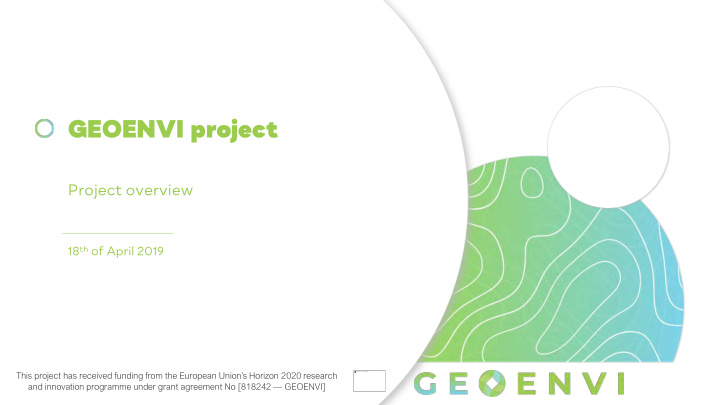



GEOENVI project Project overview 18 th of April 2019 This project has received funding from the European Union’s Horizon 2020 research The picture can't be displayed. and innovation programme under grant agreement No [818242 — GEOENVI]
Where it comes from…
3 / Project overview Where it comes from… 1. The advantages of using geothermal for power production and H&C are not widely known. Recently, deep geothermal energy production in some regions is confronted with a negative perception, and a special attention from some decision-makers, in terms of environmental performance, which could seriously hamper its market uptake. 2. Media reports focus more on disadvantages than advantages. As a result, decision makers and potential investors have concerns about possible environmental impacts and risks involved in implementing geothermal projects, and social resistance often results in practical obstacles - such as significant slowdowns - to the deployment of the deep geothermal resources.
4 / Project overview Consortium
5 / Project overview Key actors Public environmental institutions and regulatory authorities > implement and/or make the • environmental regulations: they will exchange on best practices, tend to adopt the GEOENVI recommendations and methodologies, and envisage the harmonization / mutual recognition with minimum standards, of their environmental regulations Industry & project developers > develop geothermal projects: they will be consulted on • environmental impact and LCA, and be asked to implement methodologies and tools. GEOENVI aims especially at representing a variety of power and DH project developers in Europe. These geothermal project developers and operators (more than 70 companies) are represented directly and indirectly by geothermal associations in GEOENVI Scientific experts > guarantee sustainability: they will support drafting of environmental regulations • for the legislators and design methodologies and tools on environmental impact and LCA for industry.
6 / Project overview Target areas GEOENVI is then targeting six countries in a first time: Iceland, France, Belgium, Italy, Hungary and Turkey. During the project results dissemination phase, the objective is to cover the rest of Europe.
7 / Project overview Work Packages
8 / Project overview Technical proposal WP 2: ENVIRONMENTAL MATTERS, Months 1-12, BRGM 1. Overall state of the art on deep geothermal environmental data (ISOR, Months 1-8) List of environmental issues: risk, impact and incidents 2. Analysis of mitigation measures (CNR, Months 2-10) Adopted solutions and recommendations to circumvent environmental concerns: Webinar on month 10 3. Stepping back considering other kinds of geothermal applications, renewable energy sources and beyond (BRGM, Months 6-10) 4. Data organization and reporting (BRGM, Months 1-12) Database on environmental matters
9 / Project overview Technical proposal WP 3: LCA METHODOLOGY, Months 1-20, Orkustofnun 1. A comprehensive analysis of the panorama of studies reporting environmental assessment & sustainability assessment for geothermal systems (Orkustofnun) (Months 1-12) 2. Elaboration of the environmental impact and LCA guidelines for geothermal energy and application to the case studies (CSGI Task leader with main contribution from ARMINES for the LCA guidelines) (Months 3-20) 3. Development of a protocol for the generation of simplified LCA models to assess environmental impacts (ARMINES) (months 12-20) 4. Testing the applicability of the guidelines and the protocol for simplified models with the stakeholders (COSVIG) (Months 12-20)
10 / Project overview Technical proposal WP 4: ENGAGE DECISION-MAKERS, Months 6 to 25, VITO 1. Decision-making process mapping (VITO) (Months 6-25) 2. Formulation of recommendations on environmental regulations (CNR) (Months 10-25) 3. Strategy for engagement and adoption of the recommendations (VITO) (Months 6-25)
11 / Project overview Technical proposal WP 5: ENGAGE MARKET ACTORS, Months 6-30, COSVIG 1. Geothermal market actors mapping (GEORG) (months 6-15) 2. Towards the adoption of the recommendation for European life cycle assessment approaches, and environmental impact methodologies of geothermal (OS) (months 16-30) training seminar 3. Stakeholder involvement: adopt the tools (COSVIG) (months 20-30) web-based platform for stakeholders
This project has received funding from the European Union’s Horizon 2020 research The picture can't be displayed. and innovation programme under grant agreement No [818242 — GEOENVI]
Recommend
More recommend